
Gentiana acaulis, the stemless gentian, or trumpet gentian, is a species of flowering plant in the family Gentianaceae, native to central and southern Europe, from Spain east to the Balkans, growing especially in mountainous regions, such as the Alps and Pyrenees, at heights of 800–3,000 m (2,625–9,843 ft).

Centaurea is a genus of over 700 species of herbaceous thistle-like flowering plants in the family Asteraceae. Members of the genus are found only north of the equator, mostly in the Eastern Hemisphere; the Middle East and surrounding regions are particularly species-rich.

Carlina is a genus of flowering plants in the family Asteraceae. It is distributed from Madeira and the Canary Islands across Europe and northern Africa to Siberia and northwestern China.
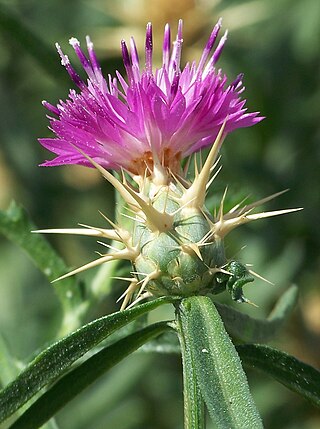
Centaurea calcitrapa is a species of flowering plant known by several common names, including red star-thistle and purple star thistle. It is native to Europe but is rarely found there, it is known across the globe as an introduced species and often a noxious weed. The species name calcitrapa comes from the word caltrop, a type of weapon covered in sharp spikes.

Centaurea solstitialis, the yellow star-thistle, is a species of thorny plant in the genus Centaurea, which is part of the family Asteraceae. A winter annual, it is native to the Mediterranean Basin region and invasive in many other places. It is also known as golden starthistle, yellow cockspur and St. Barnaby's thistle.
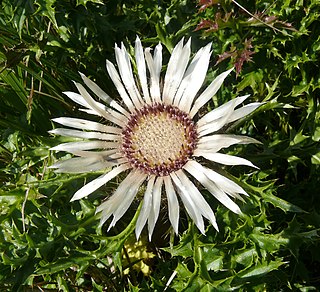
Carlina acaulis, the stemless carline thistle, dwarf carline thistle, or silver thistle, is a perennial dicotyledonous flowering plant in the family Asteraceae, native to alpine regions of central and southern Europe. The specific name acaulis and common names are descriptive of the manner in which its flower head rests directly upon a basal leaf rosette. The plant is named after Charlemagne who searched for a treatment against the plague. He dreamed of an angel who told him to shoot an arrow in the sky and see on what plant the arrow would hit. This plant would bring relieve to the plague. The plant the arrow hit was the Carlina acaulis, the roots of the plant were distributed among the population following which the plague diminished.

Centaurea melitensis is an annual plant in the family Asteraceae, 1 to 11 decimetres high, with resin-dotted leaves and spine-tipped phyllaries. This plant is native to the Mediterranean region of Europe and Africa. It was introduced to North America in the 18th century; the first documented occurrence in California is in the adobe of a building constructed in San Fernando in 1797. It is also naturalized on a number of Pacific islands.

Phoenix acaulis the dwarf date palm or stemless date palm, is a species of flowering plant in the palm family, native to northern India, Bhutan and Nepal. Found in altitudes from 350 to 1500 m, Phoenix acaulis grows in scrubland, savannas and in pine forests. Trunks in this species remain underground or, at most, grow to a few inches in height. Leaves are 1.5 m long, gray-green, with 25 cm, pinnately arranged leaflets on short, armed petioles.

Stenotus acaulis is a species of flowering plant in the family Asteraceae known by the common name stemless mock goldenweed.

Tetraneuris acaulis is a North American species of flowering plants in the sunflower family. It is known by many common names in English including stemless four-nerve daisy, stemless hymenoxys, butte marigold, and stemless rubberweed.
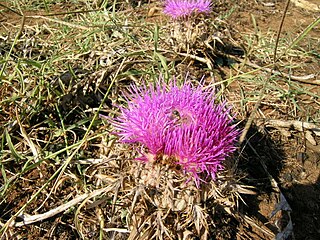
Chamaeleon gummifer, also known as distaff thistle or stemless atractylis, is a thistle in the Chamaeleon genus. Formerly, it was placed in the Atractylis genus. It is native to the Mediterranean basin, where it can be found in various habitats, including cultivated- or uncultivated fields and forests. It is a perennial herb producing a stemless, pinkish flower. The plant has a history of use in folk medicine, but it is very toxic due to the presence of atractyloside and carboxyatractyloside.

Atractylis cancellata is a species of annual herb in the family Asteraceae. They have a self-supporting growth form and simple, broad leaves and dry fruit. Individuals can grow to 2 cm (0.79 in) tall.
Carlina involucrata is a species of perennial herb in the family Asteraceae. They have a self-supporting growth form and broad leaves.
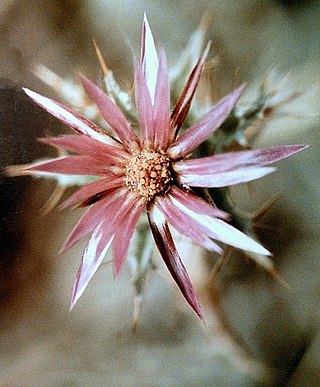
Carlina lanata is a species of plant in the family Asteraceae.

Carthamus caeruleus is a species of plants in the family Asteraceae.
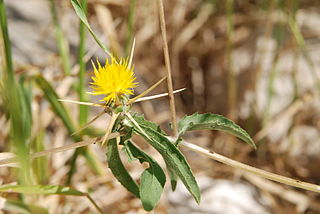
Centaurea hyalolepis is a species of plant in the family Asteraceae.
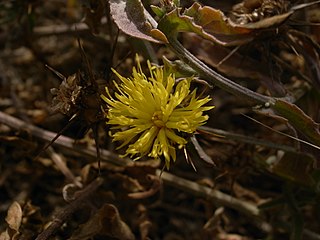
Centaurea nicaeensis is a plant species in the family Asteraceae.
Hypericum australe is a species of plant in the family Hypericaceae. Individuals can grow to 24 cm tall.
Launaea resedifolia is a plant species in the family Asteraceae.
















